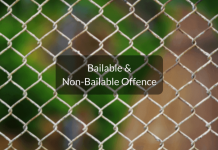This article is written by Pratiksha Goyal from the University of Petroleum and Energy Studies and it aims to explain the different stages of a murder trial in India.
Table of Contents
Introduction
According to Section 300 of the Indian Penal Code, 1860, murder is defined as an act which:
- Is committed with the intention of causing death and which resulted in the death of that person, or
- Is done with the intention of causing such bodily injury that the accused know to be likely to cause death to that person or knows it to be sufficient in the ordinary cause of nature to cause death, or
- Is done knowing that it is dangerous and is likely to cause death or such bodily injury that can result in death.
Classification of Criminal Law
In India, a person accused of murder is tried under criminal law. There are mainly three acts constituting the criminal law:
- Indian Penal Code, 1860 (IPC)
- Code of Criminal Procedure, 1973 (CrPC)
- Indian Evidence Act, 1872 (IEA)
There are two types of criminal laws in India, one is substantive criminal law, that is, Indian Penal Code, 1860 and the second is procedural civil law, that is, Criminal Procedure Code, 1973, and Indian Evidence Act, 1872.
CrPC helps provide a mechanism to conduct criminal trials in India, which begins after a charge is framed and with the court’s declaration. The CrPC provides with a procedure for a manner of:
- collection of witness evidence;
- arrests;
- safeguards;
- interrogation of the accused;
- procedure to be adopted by the court and the police;
- bail procedure;
- criminal trial procedure.
The IPC is the penal law of India and is applicable to all offences of India, except for the one which may be provided by any other law. It defines murder and provides punishment for the same under Section 302.
The IEA facilitates and provides for the manner of the procedure to be undertaken for the production of evidence in the trial and the evidentiary value attached to such evidence.
Adversarial System
It is also important to understand that India follows the Adversarial system, which means the onus of proof is on the prosecution, that is, the state to prove the case against the person accused of murder. Moreover, the accused will be presumed to be innocent until all the allegations made against him/her have been proved beyond a reasonable doubt.
Types of bails and offences
To understand the process of a murder trial, these basic terminology needs to be understood.
Cognizable Offence/case
It has been defined under Section 2(c) of the CrPC as the offences for which the police officer need not arrange for a warrant from the magistrate to arrest the accused. These are serious offences and can be punishable with imprisonment for three years or more.
Non-Cognizable offence/case
It has been defined in Section 2(l) of the CrPC as the offences for which the police officer needs to arrange for a warrant from the magistrate to arrest the accused. These are punishable with imprisonment for less than three years or with fine only.
Bailable Offence
These are those offences for which bail can be granted by the police authority. For claiming the bail, certain conditions need to be fulfilled mentioned under Section 436.
Non-Bailable Offence
These are those offences for which bail cannot be granted by the police authority and completely lies in the purview of the judicial bodies. It can only be granted on the judicial discretion of the Court. The accused can apply for the bail as under Section 437 and 439 of the CrPC.
According to Section 302 of the IPC, the person who commits murder can be punished with death, or imprisonment for a lifetime, and with a fine as well. Moreover, it is a non-bailable and cognizable offence.
Types of Criminal Trial
As per the CrPC, there are three types of criminal trial in India.
Warrant Cases
According to Section 2(x) of the CrPC, these are those cases for which the offence is punishable with imprisonment exceeding two years (or for life), or with death.
Summon Cases
According to Section 2(w) of the CrPC, these are those cases for which the offence is punishable with imprisonment for less than two years.
Summary Trial
These are generally for the small offences and only last for one or two hearings to decide the matter. The offence in question is not generally punishable with imprisonment for more than six months. The procedure for the same has been mentioned in Section 260 to 265 of the CrPC.
For this article, we will be discussing the different stages of warrant cases as murder will come under its purview.
Stages of a Murder Trial
Complaint to the Police or the Magistrate
After a murder has been committed, the pre-trial stage starts when a complaint has been filed with the police. The police file a First Information Report, which is the information given to the police about the offence. As per Section 154 of the CrPC, the information given must be reduced to writing by the police and the same must be read over to the informant.
The same complaint can also be made to a magistrate. As per the Section 2(d) of the CrPC, ‘complaint’ means anything alleged orally or in writing to a magistrate with the intention of taking action under this code against a person who has committed an offence but does not have a police report.
He has the option to take cognizance of the offence and can proceed to record the statement of the complainant and the witness as stated in Section 200 of the CrPC. if the magistrate finds no sufficient ground for proceeding then he may dismiss the complaint under Section 203. However, if the finds it to be of sufficient grounds, he may issue a warrant case as under Section 204.
He can also if he thinks fit, postpone the issue of process and choose to either inquire into the case himself or can direct a police officer or such other person for investigation for the purpose of deciding whether there are sufficient grounds for proceeding.
Investigation
The police conduct an investigation for:
- Statement of witnesses;
- Interrogation statement of accused;
- Collection of evidence.
As per Section 27 of the IEA, the police officer-in-charge can seize or search the material that is in possession or kept elsewhere by the accused.
Arresting the accused and concept of remand
The police have the option to arrest the accused without a warrant as murder is a cognizable offence. However, they need to produce him in front of the magistrate within 24 hours. In case their investigation cannot be completed within 24 hours, the police can apply for police custody of the accused. The process is known as remand which holds the person in custody till their trial or conviction in a serious crime like murder and is also referred to as pre-trial detention. However, as per Section 167, the magistrate can allow for the custody of the accused of not more than 15 days.
Moreover, the magistrate can allow for the detention of accused, otherwise than in police custody, for more than 15 days if he is satisfied that there are adequate grounds for doing so. However, no magistrate can allow detention of the accused of a period exceeding 90 days, where the investigation is related to the offence which is punishable with death, imprisonment for life or for a term not less than ten years.
Charge Sheet
After the completion of the investigation, a charge sheet against the accused is prepared by the police, which contains the elements of the offence in the prescribed form. Moreover, it also includes complete investigation of the police authorities, charges slapped against the accused, all facts, lists and statements of the witnesses (Section 161 of CrPC), a copy of FIR, and list of seizure and other documentary evidence. A public prosecutor, representing the state, files the charge sheet in the court. In case the police feel that there is no prima facie case, then the final report is filed in the court.
Cognizance of Offence by Magistrate
As per Section 190 of the CrPC, the magistrate takes of an offence committed by the accused when:
- Receives a complaint of facts that is constituting such offence;
- Upon submission of charge sheet by the police;
- Upon receiving such information from anyone other than the police officer.
In R.R Chari v. The State of U.P, the Supreme Court said that “taking cognizance does not involve any formal action or indeed action of any kind but occurs as soon as a Magistrate as such applies his mind to the suspected commission of the offence”.
Service of the warrant to accused
The accused shall be brought before the court and the public prosecutor should open the case and describe the charges against him and evidence that proves the guilt of the accused.
After considering the records of the case and the documents submitted and after hearing both the sides, if the judge finds that there are not sufficient grounds for proceeding against the accused then he is discharged giving reasons for doing so.
But in case the judge finds it to be of sufficient grounds for presuming the guilt of the accused then he may frame charges against the accused in writing. The judge is only to consider the documents presented by the prosecution at this stage and the accused is not entitled to do the same. After the charges have been framed, the same must be read over and explained to the accused. The accused then have the option to plead guilty of the offence he is charged with or can claim to be tried for the charges.
According to Section 220 of CrPC, if the accused pleads guilty for the charges, the judge must record the plea and can in his own discretion convict him thereafter. Section 220 allows the judges to convict the accused in his own discretion if he pleads guilty but it is desirable for the accused to be straightway convicted in case of grave offences like murder.
Commencement of a trial
In case the accused pleads not guilty for murder, the court calls upon the prosecution and fixes a day for examination of the witnesses. The court can allow cross-examination of any prosecution witness. Once all the evidence of the prosecution has been concluded and examined, the court calls upon the accused for his defence. As per Section 342 of the CrPC, the court has to examine and question the accused in order to enable the accused to explain any circumstantial appearing in the evidence presented by the prosecution against him. As under Section 232, after the examination of the accused the court post the case for hearing. If after hearing the prosecution and the accused the judge feel that there is no evidence that indicates that the accused has committed the offence then the judge can record an order of acquittal as mentioned under Section 232.
However, if after hearing under Section 232 the accused is not acquitted, then the accused can present his defence or any evidence which he might have in support thereof. After the conclusion of the defence evidence, the case final argument is called upon.
Final Argument
It is after the final arguments have been presented by the prosecution and accused the judge decides whether to acquit or convict the accused. According to Section 314 of the CrPC, any of the two-party in a proceeding can as soon as after the close of his evidence, before he concludes his oral arguments, if any, has to submit a memorandum to the court along with arguments in support of his case and a copy of the same to the opposite party.
Judgement
The judge either acquits or convicts the accused after the case has been presented by both sides. It is referred to as judgement.
As per Section 250 of CrPC, if an accused is discharged or acquitted and if the person who made the complaint against him is present then the court may call him to show why he should not pay any compensation to the accused. In case he is not present then summon is issued for the same.
Conclusion
Even though the Indian Criminal Justice System appears to be adequate because of numerous statutes, that has not been the case. It has been noted that there exists a backlog of pendency of cases at both- Court level and Police level. It has been seen that the backlog of the court is way greater than the police, however, that does not mean the police are working effectively because in some places crimes go unreported.
Another reason for its inadequacy is the disproportionality in the personnel in both the sphere compared to the cases in hand. It leads to slower functioning of the courts and it takes longer than usual to dispose-off cases.
LawSikho has created a telegram group for exchanging legal knowledge, referrals and various opportunities. You can click on this link and join:
 Serato DJ Crack 2025Serato DJ PRO Crack
Serato DJ Crack 2025Serato DJ PRO Crack











 Allow notifications
Allow notifications



